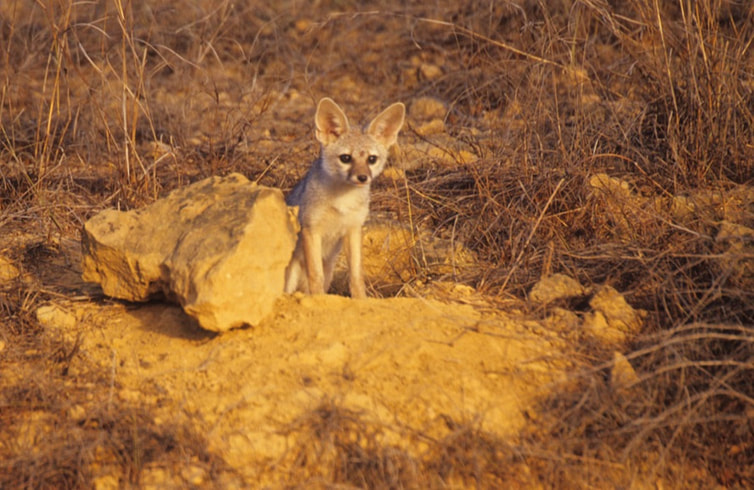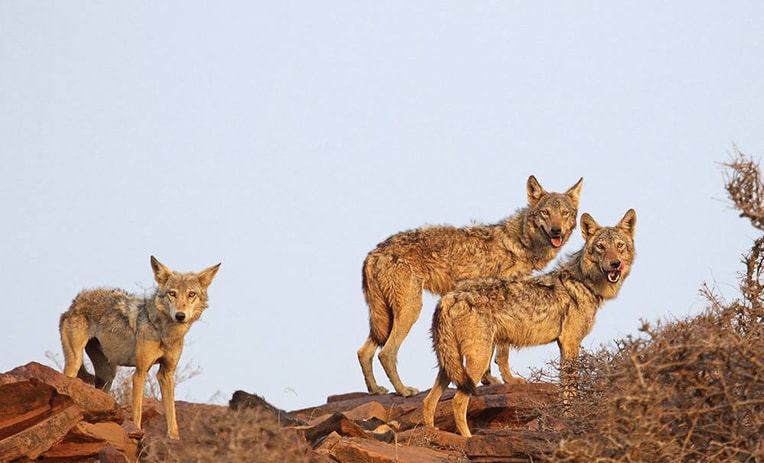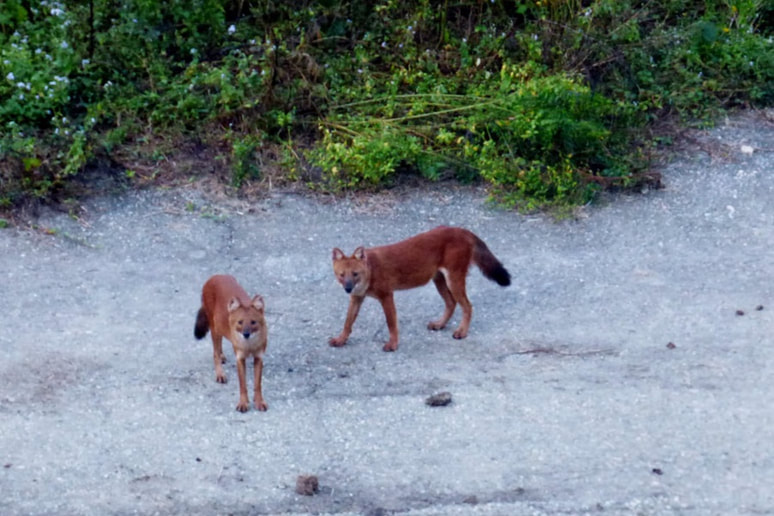|
Chandrima Home It was a chilly December in 2004 when I landed up in a “heritage village”–Tera– in Kachchh, about 90 km away from Bhuj, Gujarat. I was studying resource-use by Indian foxes in this landscape as a part of my Masters dissertation. My initial field days started with looking around for fox dens with Vilji Bhai, a member of the Koli tribe (a hunting tribe) who had a remarkable sharpness to detect animals. Once an active den was identified, I would find a suitable place about 200–300 meters away and observe the den site from dawn to dusk. Since it was the breeding season, foxes actively used dens for raising their young. One of the den sites in Kakribet was ideally located amidst small hillocks. I positioned myself atop a hillock with a spotting scope, a bag full of field supplies and a flashlight. The field station coordinator was instructed to pick me up by 6 pm since my teammates were heading off for a vulture survey and would be late. Contrary to my expectations, the level of activity at the den was minimal. The fox went for a short stroll and once back, it did not venture out from the den. As dusk approached, there was still no sign of the vehicle to pick me up. Through the curtain of darkness, all that I could see were the silhouettes of hillocks and acacia trees around me. I tried to find my way out using my flashlight, but realized that the beam was not powerful enough. As soon as the sun went down, the mercury dipped and the only thing that made me anxious was I may not be adequately equipped with warm clothes. But there was nothing much that could be done since the vehicle that was supposed to pick me up had still not arrived. I convinced myself that Kachchh was safe since there are no large carnivores (except the Indian wolf, which was a rare sighting). As darkness descended, the landscape came alive. I could distinctly hear mating calls of foxes. This was intermittently broken by faint dog howls from faraway villages. At 9:30 pm it was pitch dark, and there was still no sign of the vehicle. A rustle in the leaves close by made my senses taut. The movement drew closer and after sometime I felt heavy breathing sounds around me. It was as if someone was sniffing me! I sat there, not moving an inch and trying not to breath. The rustling stopped and after a few minutes of eerie silence came a train of deafening howls. It was a group of jackals (may be 4 to 5 of them) that had come to inspect me. They were perhaps within 5 to 10 meters away when they all decided to howl. After some time the rustling died down and I presumed that the jackals had moved on.
I was eventually picked up around midnight. Though my body was numb with cold, my mind was racing with the fascinating acoustic experience! For the next couple of months in field, I observed jackals to be extremely wary of humans. My closest encounters have been at least 50 meters away. That night was the closest I could see (or rather hear) them, and perhaps the closest I have been to jackals in all these years.
0 Comments
Priya Ranganathan Dusk was settling over the grey waters of the Chambal. The sky, which had been clear and bright up until thirty minutes ago, was now settling into deeper shades of blue and purple. As my field assistant would say, the hunting hour was fast approaching. He was talking, of course, about the Indian wolf. It was in these ravine systems where I had a rather nerve-wracking encounter with wolves. It began when our driver deserted us in the ravines. The jeep was cranky and old and refused to traverse the narrow sandy ridges. So he stopped the jeep and told us to go along the transects. My field assistant and I walked for over an hour through a system of confusing ravines, marking GPS points, marking scats, pellets, signs, and pugmarks. We eventually found ourselves on a sandy bank with the Chambal river sprawled out before us. That was when I noticed the pugmarks by the water, right where we were standing. “Wolves,” I said, nudging my field assistant. He came over to look. “We should call the driver,” he said nervously. Wolves do not have a positive reputation with many of the local tribes in this region. Pacing along the riverbank, I looked up at the darkening ravines looming above us and made a decision- to retrace our steps to where we left the jeep. My field assistant was less than pleased. Retracing your steps with a nervous field assistant continuously muttering about bad omens in your ear is hard. “Madam, are we lost?” my assistant asked feebly, when I stopped and puzzled. That was when the howls began. My assistant couldn’t help the shriek that left his mouth as the eerie howling of wolves was picked up by two, three, five, six animals, seemingly surrounding the gorge where we stood. My eyes struggled to acclimatize to the shadowy darkness. I heard rustling from above, where the low sandy cliffs nearly met over our heads and tried to slow the thumping of my heart. The howls grew in volume and intensity. My assistant suggested we play loud music and sing along! “The wolves will hear the songs and think we are a large group of people. They will stay away from us.” I was already worried about finding our way back to the jeep, so I gave in. Singing along to racy Hindi songs while running away from wolf hunting grounds was definitely not part of my internship contract. It was when I looked up at the dark sloping ravines above us that I saw their glowing eyes. We were intruders in their habitat, but they were keeping a distance from the cacophony we were causing. After that first glimpse of the wolves, I kept a lookout for more of those elusive canids. After half an hour of wandering blindly through wolf country, we heard faint shouts and saw flashing lights. My teammate and the driver had found us! The howls of the wolves faded away, and as we reunited with our teammates, I looked back at the shadowy ravines from where I had emerged.
The wolves had vanished, melting back into the shadows. All that was left were pugmarks and the echoes of howls in the night wind above the Chambal. Mridula Vijairaghavan It was a crisp January morning in 2017 in Dandeli Wildlife Sanctuary. My family and I drove slowly by, soaking in the beauty of the forest. Amidst the the canopies bustling with bird activity, we got glimpses of Malabar pied hornbills, crested serpent eagle and racket tailed drongo amongst other birds. Giant wood spiders sat motionless, squarely in the middle of their large, intricate webs that were suspended off trees along the road. We heard the asyncronous symphony of barbets in the distance, while rays of sunshine streamed in through the thick canopy. Dandeli is a stunning mixture of dense deciduous forest interspersed with bamboo and ancient teak plantations. We were traversing through a relatively undisturbed patch of forest, teeming with a myriad of life forms. As we trundled along the path, we chanced upon an unsuspecting Indian fox trotting through the shrubs by the side of the road. Fascinated, we watched it do this for a few minutes before we drove past the little canid and went our way. The fox seemed rather unperturbed by the vehicle and moved at a pace that almost made it seem like it had some urgent task to tend to! The Indian fox is found across large parts of India. In fact, it is among the most widespread carnivore species in India. Most field guides suggest that Indian foxes are mainly found in open dry habitats such as grasslands and scrublands. They are also found in agricultural fields, having adapted to a diet predominantly composed of rodents. I had no idea at the time of my sighting that it was in an atypical habitat for Indian fox. It was only while reporting the sighting on Wild Canids–India Project that it came as a pleasant surprise. This sighting of the fox is one that is clearly etched in my mind, and it is all the more fascinating to realize that the one stray incident offered some new learnings, nearly two years later.
Iravatee Majgaonkar An ordinary agricultural landscape in the arid peninsular India and there is nothing much one notices apart from people, farmlands and livestock. Only with a closer look do you realize that there are hidden elements here, and the most enigmatic of these is the Indian grey wolf. It doesn’t have a spine-chilling growl or stripes and rosettes or even the ability to take down very large prey. But you may be just a few metres away and it knows how to disappear into the agricultural fields and you would never know. It would be panning the landscape from an elevated mound or moving across some rare patches of grasslands, but so well-blended that you may never get to see it. Wolves have the ability to appear and disappear at unexpected times and this is what makes them magical. They are not like the European or North American ones – grey, furry and large. They are some shade of taupe, just about mildly furry and rather lanky. They are social animals, i.e. they live in packs and generally one pair amongst them gives birth to a litter of pups during the colder months. All members of the pack help in raising the litter, and the pups start moving with the pack after they are above 7 to 8 months old. While they are known to prey on antelopes and livestock, they don’t mind some vegetables once in a while. None of us know how many wolves currently roam peninsular India and what the future holds for this extraordinary animal. There are some special people in the arid areas of peninsular India who know these lands and the wolves very closely: the nomadic pastoralists. These groups move from one harvested field to the other, tracking fodder and water. One might chance upon them herding thousands of sheep along the roadside, carrying their entire household on horseback, and collared dogs moving amidst them. They can be distinguished from local pastoral groups by the womenfolk who move along with the horses and young children, and men herding livestock wearing brightly coloured turbans and gold in their ears. Wolves often take their livestock. But there is something unique about their relations with them, evident from some cultural narratives that one gets to hear. Some say that wolves are brothers and some say they are maternal uncles (Sodara mava in Kannada). As a family member, the wolf deserves a small share of the livestock. The story goes that wolves bless livestock through the occasional visits and the herd prospers if wolves take livestock on certain instances. So has the need for taking livestock recognized and valued by the people? And does this foster acceptance in these landscapes? At least the next time we hear stories about ‘the big bad wolf’, ‘the cunning wolf’ or ‘the wolf in sheep’s clothing’, we might remember this story from the heart of the Deccan peninsula. It reminds us that there are such beautiful, positive relationships between humans and wildlife, right here in India.
Malaika Mathew Chawla My college friends and I were in Deussua, South Goa. Our field station was a cattle shed. The sky got lilac and then grey, full of birds and then bats. Grazing cows were heading back into their sheds and the poder (bread maker) with his horn entered the village on his bicycle. At sharp seven, the church bell rings. Almost immediately, the entire village erupts with sharp, piercing cries. The jackals have arrived. Just in that moment, every other being and sound become insignificant. Bhagrati bhaiya, a migrant worker employed at the cattle shed, remained cool and said in matter-of-fact manner: “Sham ke chaar baje, kutton ke jaise idhar udhar ghoomenge aur phir raat ko bahut awaaz karenge” (At 4 in the evening, they will roam around like dogs and then they make a lot of noise at night). The golden jackal Canis aureus is found in many semi-rural landscapes of Goa. So much so that it finds a place in folksongs– mando and dulpod– and folktales. Children grow up listening to stories of kolo mama (Uncle Jackal) and kolo mami (Aunty Jackal). In one such story, the jackal climbs up the jamun tree to feed on ripened berries. The neighborhood children call out, “Kolo mama, kolo mama! Amkai thodi jamblam udoi re” (Uncle Jackal, please throw down some berries for us!). Instead, kolo mama has a good meal of the jamun and throws the seeds at the children. Other than sighting them, there is also hope and excitement with finding jackal scat. We learnt that the jackals fancied the same berries as we did– Syzigium caryophyllatum or ‘bhedsa’ in Konkani. I also recall being warned by neighbours about ‘foxes’ in the village. In Konkani, ‘kolo’– the term meant for jackals– is wrongly translated into English as fox.
Queries about jackals elicited a range of responses from residents of the village. Some were indifferent, some nostalgic, while some shared fascinating stories. One story, retold with relish, was that of a man who was circled by jackals in a field. Apparently, in an act of self-defense, he takes out his violin and plays a tune. Listening to this, the jackals take flight. Another story brought deep-searing pain, of a jackal pup, separated from his mother and sold, in the guise of a German shepherd dog. Day after day in our cattle shed “field station” we dreamt with open eyes. Of jackal packs with their pups, munching on jamun and living free. Not just in a village in Goa, but wherever they choose to be. Arkajyoti Shome It was a chilly December morning in Buxa. Accompanied by Sitaram, my field assistant, we went to observe the Great hornbills at their roost site. We reached there before sunrise, and were waiting at a watchtower which was adjacent to the cliff where hornbills roost. While we sat there waiting for the sunrise, we could hear the calls of different birds. It was like an orchestral performance. Just when there was a hint of light pouring in down on the forest floor, tearing apart the dense canopy, we could see some movement in the undergrowth just opposite the watchtower. We were exhilarated to see a pack of dholes emerging out of the undergrowth and coming down to the waterhole in front of the watchtower. In the meantime, a wild boar had also arrived at the same place from a different direction. Seeing the pack, it bolted away! Interestingly till this time, they hadn’t noticed us. The dholes went out around the waterhole, making sure nothing else was present near them. They looked at us for a few moments, then looked at each other, and decided to take a bath on that chilly winter morning! While they bathed and drank water one of them was keeping an eye on us. We sat perfectly still except for my finger which moved to click the shutter of my camera. Once they were done, they went into the undergrowth and sat consecutively like the formation of a railway coach, one beside the other, looking straight up at us. With all ten eyes gleaming at us, all I could think now was about those “shy” canids, and unaware of my surroundings. Almost 10–15 minutes passed with them staring at us. What they did after that was amazing. The one sitting the farthest from us disappeared into the dense vegetation inside, then another one and followed by the other two. But still, one individual was sitting there and looking up at us. Soon after, we heard the whistling sound of those individuals. We thought this to be the signal for the sentinel to join them, and leave us silly humans behind!
|






 RSS Feed
RSS Feed
